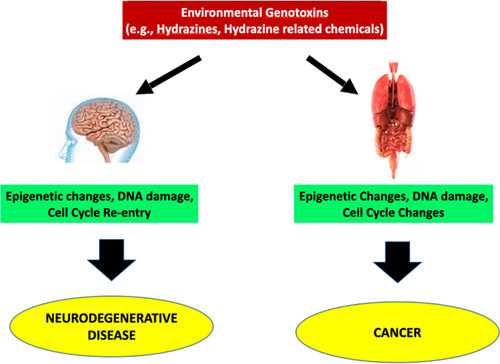当前位置:
X-MOL 学术
›
Chem. Res. Toxicol.
›
论文详情
Our official English website, www.x-mol.net, welcomes your feedback! (Note: you will need to create a separate account there.)
Role of Hydrazine-Related Chemicals in Cancer and Neurodegenerative Disease
Chemical Research in Toxicology ( IF 4.1 ) Pub Date : 2021-08-11 , DOI: 10.1021/acs.chemrestox.1c00150 Peter S Spencer 1 , Glen E Kisby 2
Chemical Research in Toxicology ( IF 4.1 ) Pub Date : 2021-08-11 , DOI: 10.1021/acs.chemrestox.1c00150 Peter S Spencer 1 , Glen E Kisby 2
Affiliation

|
Hydrazine-related chemicals (HRCs) with carcinogenic and neurotoxic potential are found in certain mushrooms and plants used for food and in products employed in various industries, including aerospace. Their propensity to induce DNA damage (mostly O6-, N7- and 8-oxo-guanine lesions) resulting in multiple downstream effects is linked with both cancer and neurological disease. For cycling cells, unrepaired DNA damage leads to mutation and uncontrolled mitosis. By contrast, postmitotic neurons attempt to re-enter the cell cycle but undergo apoptosis or nonapoptotic cell death. Biomarkers of exposure to HRCs can be used to explore whether these substances are risk factors for sporadic amyotrophic laterals sclerosis and other noninherited neurodegenerative diseases, which is the focus of this paper.
中文翻译:

肼相关化学物质在癌症和神经退行性疾病中的作用
在某些用于食品的蘑菇和植物以及包括航空航天在内的各个行业使用的产品中发现了具有致癌和神经毒性潜力的肼相关化学品 (HRC)。它们倾向于诱导 DNA 损伤(主要是O 6 -、N 7- 和 8-氧代鸟嘌呤病变)导致多种下游效应与癌症和神经系统疾病有关。对于循环细胞,未修复的 DNA 损伤会导致突变和不受控制的有丝分裂。相比之下,有丝分裂后神经元试图重新进入细胞周期,但会经历凋亡或非凋亡细胞死亡。暴露于 HRC 的生物标志物可用于探索这些物质是否是散发性肌萎缩侧索硬化和其他非遗传性神经退行性疾病的危险因素,这是本文的重点。
更新日期:2021-09-20
中文翻译:

肼相关化学物质在癌症和神经退行性疾病中的作用
在某些用于食品的蘑菇和植物以及包括航空航天在内的各个行业使用的产品中发现了具有致癌和神经毒性潜力的肼相关化学品 (HRC)。它们倾向于诱导 DNA 损伤(主要是O 6 -、N 7- 和 8-氧代鸟嘌呤病变)导致多种下游效应与癌症和神经系统疾病有关。对于循环细胞,未修复的 DNA 损伤会导致突变和不受控制的有丝分裂。相比之下,有丝分裂后神经元试图重新进入细胞周期,但会经历凋亡或非凋亡细胞死亡。暴露于 HRC 的生物标志物可用于探索这些物质是否是散发性肌萎缩侧索硬化和其他非遗传性神经退行性疾病的危险因素,这是本文的重点。



























 京公网安备 11010802027423号
京公网安备 11010802027423号